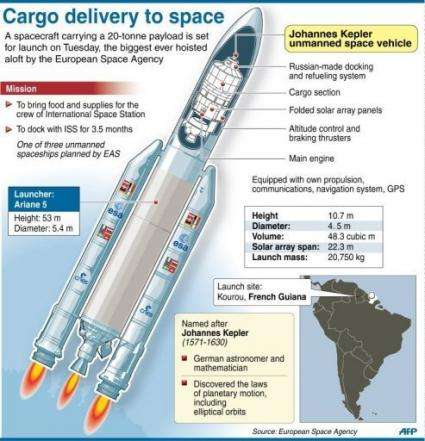Europe set for landmark launch with robot freighter

A robot freighter is poised to blast into the skies on Tuesday in the heftiest liftoff in Europe's space programme that will also bring its tally of launches to a historic 200.
Designed to supply mankind's outpost in orbit, the Johannes Kepler will be hoisted by an Ariane 5 ES super-rocket from Kourou, French Guiana. Liftoff is pencilled for 2208 GMT.
A successful mission will boost the case for scientists who want the ATV to be the template of a manned spacecraft, placing ESA on an equal footing with the United States, Russia and China.
With a mass of more than 20 tonnes, the payload is the biggest ever taken aloft by the European Space Agency (ESA).
It is a monster compared with the 1.6-tonne test satellite launched in 1979 by Ariane 1, the pencil-thin trailblazer in ESA's exploration of space.
The unmanned supply ship is scheduled to navigate by starlight towards the International Space Station (ISS) and dock with it automatically, a feat of precision unmatched by any other space power.
"We will be working at a speed of around 28,000 kilometers (17,500 miles) per hour and our approach will be at seven centimetres (2.8 inches) a second, so although we are moving at this high speed, we will really be approaching the ISS very gently," explained mission director Kris Capelle.
The Johannes Kepler is the second of five Automated Transfer Vehicles (ATVs) that the ESA is building for the ISS.
The prototype ATV, the Jules Verne, carried out a flawless mission in 2008, silencing those who predicted an expensive firework display or a lethal collision with the space station.

If all goes well, its successor will dock with the ISS on February 23, carrying 7.1 tonnes of fuel, dry goods, oxygen and a scientific experiment, more than three times the load of Russia's Progress supply ship.
But it will not be bringing water, as the six ISS crew already have plenty of the precious stuff, says ESA.
It will then be used as a spare room and for storage, easing the cramped conditions for the ISS crew, and fire its onboard engines to boost the station's altitude in six steps.
The ISS is in low orbit, but loses altitude because it is tugged by the tendrils of Earth's atmosphere. It is currently at around 360 kilometres (225 miles) and needs boosting to some 400 kms (250 miles).
On June 4, the Johannes Kepler will undock, laden with rubbish, human waste and unwanted hardware, and then go on a suicide plunge, burning up over the South Pacific.
Widely applauded for its robot missions, ESA has never had its own manned spaceflight capability. Its astronauts hitch rides with the US space shuttle -- due to be phased out this year -- and Russia's Soyuz.
"In the ATV, there are technological elements which are absolutely fine for transporting astronauts," said Olivier de la Bourdonnaye, director of the ATV 2 programme at Astrium Space Transportation.
"The docking system and propulsion system in particular meet all the safety standards for manned flight. However, to carry a crew, you need a whole lot more, notably a spacecraft that can cope with re-entry."
The first step towards this has been taken with a study for a experimental re-entry vehicle which will carry back instruments back to Earth as a test of survival.
The Johannes Kepler is named after the great German mathematician of the 16th and 17th centuries who first calculated the movement of planetary bodies in elliptical orbits, paving the way to Isaac Newton's theories of gravitation.
(c) 2011 AFP





















